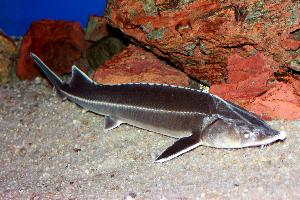
Váhy a míry
| Hmotnost | od 150 do 330 kg |
|---|
Popis zvířete
The European sea sturgeon, scientifically known as Acipenser sturio, is a fascinating and ancient species of fish that has been swimming in the Earth's waters for over 200 million years. This remarkable creature is part of the Acipenseridae family, which includes several other sturgeon species. The European sea sturgeon is particularly noteworthy for its size, longevity, and the unique role it plays in its ecosystem.One of the most distinctive features of the European sea sturgeon is its physical appearance. This fish can grow to impressive lengths, with some individuals reaching up to 3.5 meters (about 11.5 feet) and weighing over 300 kilograms (approximately 660 pounds), though such giants have become rare. Its body is elongated and torpedo-shaped, covered in five rows of bony plates known as scutes rather than scales, which provide protection. The skin is typically grayish or brownish on the back, transitioning to a lighter, almost white underbelly. The sturgeon's snout is long and pointed, equipped with barbels near the mouth that help it detect prey on the muddy river bottoms.
Acipenser sturio is an anadromous species, meaning it migrates from the saltwater of the seas to the freshwater of rivers to spawn. Historically, this migration pattern was observed in many European rivers, stretching from the North Sea to the Mediterranean and the Black Sea. However, due to overfishing, pollution, habitat loss, and the construction of dams that block their migratory paths, the European sea sturgeon's range has dramatically decreased. Today, it is considered critically endangered, with one of the last known breeding populations found in the Gironde River in France.
The diet of the European sea sturgeon primarily consists of small fish, crustaceans, and mollusks. Its method of feeding is quite unique; the sturgeon uses its sensitive barbels to detect prey before sucking it into its mouth, which is capable of protruding outward.
Reproduction in Acipenser sturio is a slow process, as the species takes many years to reach sexual maturity—males around 8 to 12 years and females around 10 to 14 years. Moreover, females do not spawn every year, sometimes taking several years between spawning events. When they do spawn, they lay hundreds of thousands of eggs in the gravelly or sandy bottoms of rivers, where the eggs stick to the substrate until hatching.
Conservation efforts for the European sea sturgeon are ongoing and include habitat restoration, pollution control, and breeding programs aimed at reintroducing the species into its historical range. These efforts are critical for the survival of this ancient fish, which has faced dramatic declines in population numbers over the past century.
In summary, the European sea sturgeon is a species of great interest due to its ancient lineage, impressive size, and unique life cycle. Despite facing significant threats, there is hope that through concerted conservation efforts, this majestic creature will continue to inhabit European waters for many years to come.
Podobná zvířata
Nové fotografie zvířat
Top 10 zvířat
- Dolphin gull (Leucophaeus scoresbii)
- Diana monkey (Cercopithecus diana)
- Moustached guenon (Cercopithecus cephus)
- Galápagos tortoise (Geochelone nigra complex)
- Japanese macaque (Macaca fuscata)
- Stone loach (Barbatula barbatula)
- Russian tortoise (Testudo horsfieldii)
- Greek tortoise (Testudo graeca)
- Common flying dragon (Draco volans)
- Vendace (Coregonus albula)

